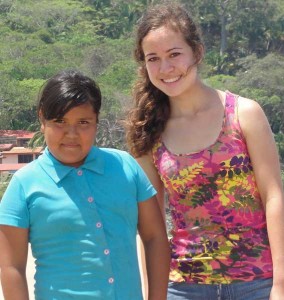By SARAH STINSON
MARIA CARRILLO HIGH SCHOOL
JUNIOR
Her smile unfurls across dimpled olive cheeks as playful competition sparks in her eyes. The memory still glimmers in my mind. I was playing basketball with my new Mexican friend Jaqui in the humid heat, while the waves roared like faraway cars. Her parents worked at the hotel in the 350-resident fishing village of Chacala. It was the summer before my junior year of high school, and I was a guest but not a tourist.
Soon after we met while eating lunch at the hotel, 10-year-old Jaqui invited me to visit her primaria (elementary) school. In my two days with the hyper fourth- and fifth-graders, we marched in formation, ate syrupy popsicles out of bags and hid behind crackling branches in a game of escondidas. All of the kids at the school I visited are the future faces of Chacala: the leaders, the workers and the dreamers.
Jaqui and I had meaningful conversations during our rosy dawn trips to school despite my flawed and textbook-rooted Spanish vocabulary. She told me she wanted to be a teacher, and I could see her eyes gleam with passion for her community and education itself.
It became clear that students in Chacala appreciate their education, perhaps because it is so limited. According to the Organization for Economic Co-operation and Development website, only 25 percent of young Mexican adults have finished a baseline qualification in upper secondary school. This is due to the government’s lack of funds and families’ inability to afford tuition. A very small percentage of students is university-bound.
A worker at my hotel told me he’d been studying technology at a renowned college but dropped out because of the tuition. I consequently learned to appreciate the education that I will continue receiving through college, not to mention the music lessons and other extracurricular activities that my parents can afford.
By observing my new friends’ lifestyles, I also learned about what it does and doesn’t take to be happy. On my last day in Chacala, Jaqui and I walked to fishermen’s boats at the dock. Angel, who I’d met at the primaria school, played with a squirming purple pulpo (octopus) he’d fetched from the ocean depths with scratched blue goggles and a hooked rod. I touched the creature, and its tentacles’ slimy suction cups gripped my fingertips with unsettling strength.
Angel obviously was a happy kid, just as happy as kids I know with higher financial situations. I learned that the average Mexican working family earns only around several thousand dollars a year — and they smile because they have food and houses and families, but not necessarily a TV or computer. I know that I and other teenagers have become quite attached to all of the latest technological gadgets. I also know that from now on I’m going to cling much less to material objects and instead try to live my life in a more fulfilling way.
Despite all of my spontaneous adventures in Chacala, what had drawn me there initially was my planned visit to a children’s program in the nearby city of Las Varas. At the program, I played games with the kids and taught English to eager high-schoolers while also practicing the Spanish I’d been learning for two years in school. We’ve kept in touch through Facebook, and they’ve messaged me in careful English: “You changed my life.” In careful Spanish, I’ve sincerely returned the message.
In Mexico, I bypassed the typical tourist experience. My new friends immersed me in their communities, which shaped my views on my own culture and lifestyle. Despite the unfamiliar culture and setting, I tasted a sliver of the same dreams common to all young people, and I realized that despite our differences, in many ways we’re the same.

